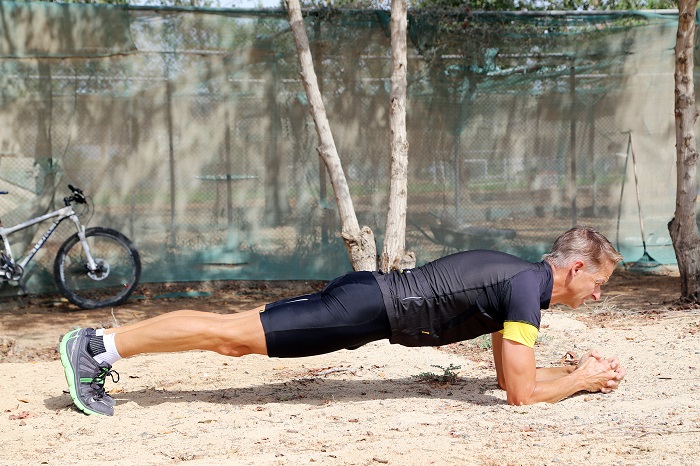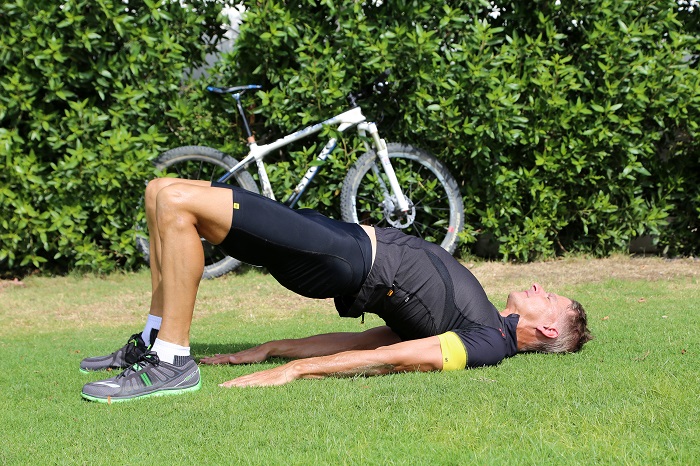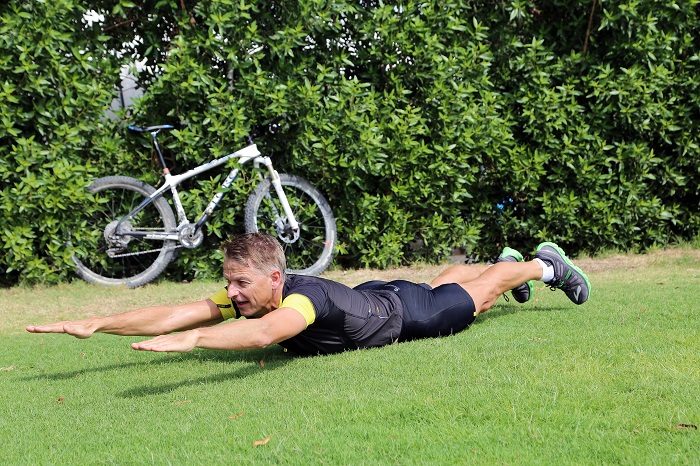This is a series of articles looking at exercises that can be used to improve your mountain biking. Amongst the topics, we are hoping to strengthen the major leg and arm muscles that you use when you ride by showing you a systematic programme that will also decrease the chance of becoming injured and make you more aware of the mechanics of your body. This month we look at exercises to improve your core.
Core exercises are very different from the more dynamic movements we showed you last month. These can be done in moments of quietness, before or after a ride.
Research on cyclists show that when the core muscles become fatigued, the mechanics of your pedal action break down and consequently your performance and efficiency drops. Injury can also follow with more form. It’s great to have super strong legs and arms but that power cannot be transmitted into the pedals unless there is a strong core platform to push off.
Perform one complete routine of each of the five exercises below, resting 15 seconds between each exercise. Aim for two sessions a week. A study in the Journal of Strength and Conditioning Research reported that cyclists who cooled down with a core workout had significantly better lactate clearance, which helps reduce muscle fatigue, than those who did nothing so a great time to do them is after a ride.
Core strength means hips, butt, lower back and abdomen. It means flexing and extending the trunk as in back extensions and crunches. It also means stabilizing against a force such as gravity in exercises such as bridging. Integration exercises that work the abdominal, back, hip and butt muscles all at the same time are the best core strengthening exercises. To improve your endurance, perform the exercises in a circuit format — one after another with little to no rest. Remember to be slow and controlled and to breathe deeply.
1. Plank

The infamous plank is the most famous exercise for strengthening the core. It builds endurance in your arms, shoulders, and core muscles. Start on your elbows with your spine as straight as possible. Hold this position for the next 30 seconds. Do not twist or sag at waist. If you want to mimic being on a mountain bike, do the plank on your hands, it strengthens the stabilizer muscles in your shoulder joint. Perform three sets of 20 repetitions with 30 seconds of rest in between. As you become more proficient, increase the time that you spend in the plank position.
2. Glute Bridge

This exercise will increase the strength of the glute. Lie on your back with your knees bent and feet flat on the floor. Extend one leg straight into the air as shown below. Raise your hips up using the strength of the opposite hip only. Keep the hips level and try not to wobble. Hold each raise for 10 seconds and lower. Repeat 10 times on each side. Keep the hips level and in line with your torso. Any weakness in the stabilizing muscles will show by a lack of balance and uneven hip position.
All of these exercises are good to do with a partner as they can watch for correct position.
3. Crunches
Crunches are great for helping the area around the abdomen and stomach. Lie on your back. Bend your knees towards your butt but keep your feet flat on floor into a comfortable position. Lift your head and shoulders off the floor and then lower slowly keeping everything in line. Keep your neck in a neutral position and don’t pull on your head or curve your spine. It is possible to increase the intensity by lifting your feet off the floor or having your legs straight. Remember it is not the number of reps you perform but the control and position you maintain. You will definitely feel a burn in your abdomen muscles doing this. Exhale deeply when you rise and inhale when you lower back down.
4. Supermans

This exercise can feel uncomfortable if you lie on a hard floor so try and place some padding such as a mat or towel. Lie on the floor on your stomach with your arms extended overhead. Look straight ahead. Using your core, lift your arms, shoulders and legs off the floor at the same time and then lower. You only need to hold in the raised position for a second and squeeze your glutes.
Every time you return to the lower position relax your body and take a deep breath before inhaling on the way up again.
Do four sets of 10 reps of the Superman raise in each cycle.
5. Hanging Knee Raise
You will need something high to hang on to for this exercise such as the pull up bars at the gym or the underside of the roof by the parking at Al Qudra. Start hanging with straight arms and legs dangling. Contract the core muscles. Lift your knees as high as you can slowly towards your waist. Remember to also lower them slowly and in control as this is half of the exercise. Try to do four sets of 10 raises.
Tips for Core Strengthening Exercises
The exercises above are a guide to get you started and you should be able to do them alone. The key is getting the correct posture and technique. There are other useful sources of information such as internet videos and professional instructors. Keep these tips in mind when you are doing the exercises alone. The more you do them, the more you will learn about your body and how it works.
- Contract your abdominal muscles (core) throughout all the exercises. Think of keeping your belly button pressed into your spine.
- Do all the exercises in a slow and controlled manner. Do not try and throw your body around and avoid jerking motions.
- Breathe slowly and smoothly throughout all the exercises. We have tried to explain when to inhale and when to exhale.
- These five exercises are the basics. There are many more. Always try and add variety into your core training routine to motivate yourself.
- As you progress, you will understand which exercises affect which muscles. Try to target your whole core by alternating abdominal, back and side exercises. Also learn to use both mobility and stability exercises.
A Workout on The Bike
The Fast Start
Last month we looked at a simple workout that involved intervals and how they could improve your biking. This month the workout is looking at how we can improve our starts.
Even if you have warmed up before a ride or a race, starting a mountain bike is always the hardest until your muscles are truly working. In a race, this is crucial especially on single track races such as Showka or Hatta where the ability to start fast and recover at race pace is important. Getting to the front could mean all the difference either for the drafting aspects and particularly as the overtaking opportunities may be fewer. The fast start is something that is trainable and if you have developed your muscle memory you will leave your opponents and friends on the trail behind you.
So to train your body to become accustomed to fast starts in a race, find a wide and flat open area that narrows down to single track after a few minutes. A few sessions like the one below will see you getting to the front a lot more easily.
You can do this session by yourself or in a group and it also provides a bit of fun. You or the group should go together on an imaginary start line as you would for a typical race. If you are using clips, snap one foot in and the other on the ground. Check that you are in the correct gear for a fast getaway. You don’t want the gears grinding when you put the power down suddenly. Get someone to call the start and accelerate quickly away. Ride at your maximum pace for one minute then without stopping, settle in at the threshold pace or heart rate zone four or power L4 for an extra nine minutes. If you don’t have an HR monitor or a power meter, this zone is roughly 80 – 90% of your maximum. It should feel that you have a conscious effort to go fast but is still comfortable and a level down from the max that you started the race at. After the nine minute mark, select an easy gear and spin back to the start or continue with your ride. Do two of these fast starts once per week during the month leading up to your next race and see how more comfortable you feel at the start of races. This workout can also be used mid race to get ahead of your opponent and get to a particularly narrow section first.





